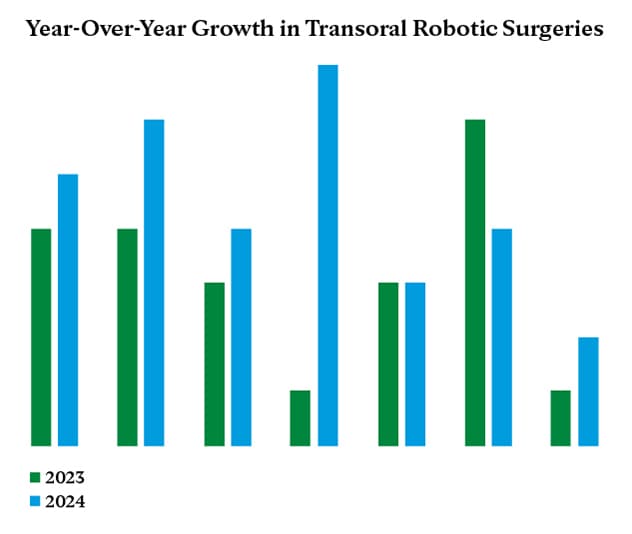Oct. 12, 2024
Mayo Clinic Otolaryngology is the most experienced program in northern Florida in dealing with the high-risk, low-volume disease of primary and recurrent head and neck cancers. In the U.S. alone, HPV is linked to about 70% of head and neck cancers. These cancer cases are increasing in two specific areas in the throat: the tonsils and the lymph node tissue in the back of the tongue.
Treating cancers in these two locations can be challenging. Innovation with robotics allows for better outcomes in terms of complete tumor removal and gives surgeons the ability to treat cancers that were once considered inoperable.
 الزيادة على أساس سنوي في الجراحة الروبوتية عبر الفم
الزيادة على أساس سنوي في الجراحة الروبوتية عبر الفم
من النصف الأول من عام 2023 وحتى النصف الأول من عام 2024، ارتفع عدد حالات الجراحة الروبوتية عبر الفم بنسبة 41% على أساس سنوي.
"Many of the challenges are often related to the location of the primary tumor because the throat and voice box area are difficult to get access to," says Phillip Pirgousis, M.D., an otolaryngologist at Mayo Clinic in Jacksonville, Florida.
As early adopters of a single-port robotic system, Mayo Clinic surgeons are using advancements in the latest technology as an opportunity to treat complex cases and increase Otolaryngology's surgical capabilities. Since 2008, Dr. Pirgousis and other otolaryngologists at Mayo Clinic in Jacksonville, including Samip Patel, M.D., and Jeffrey R. Janus, M.D., have used robotic surgery to operate on hundreds of patients with head and neck cancers. To this end, the use of transoral robotic surgery (TORS) in Otolaryngology at Mayo Clinic in Jacksonville, Florida, is increasing steadily, with a 41% increase in cases year-over-year.
Other conditions treated using TORS:
- Hypopharyngeal cancer
- Laryngeal cancer
- Nasal cavity cancer
- Nasopharyngeal cancer
- Oral cavity cancer
- Oropharyngeal cancer
- Salivary gland cancer
During TORS, a surgeon uses robotic instruments within a single port along with a computer console to operate on hard-to-reach areas in the back of the throat. This is a minimally invasive surgery that removes cancers that would be hard to access otherwise.
Another advantage of the single-port system is that more patients with cancer are candidates for robotic throat surgery than with the traditional multiarm robotic system. For example, the single-port system makes robotic surgery accessible to patients with tight throats, including those with sleep apnea.
Postoperative benefits include reduced pain and scarring, fewer complications, and a shorter hospital stay. Patients also experience fewer surgical side effects related to breathing, speaking, swallowing and communicating.
"This advancement has improved the ability for us to not only completely remove tumors, but to remove them safely," says Dr. Pirgousis.
For more information
Refer a patient to Mayo Clinic.